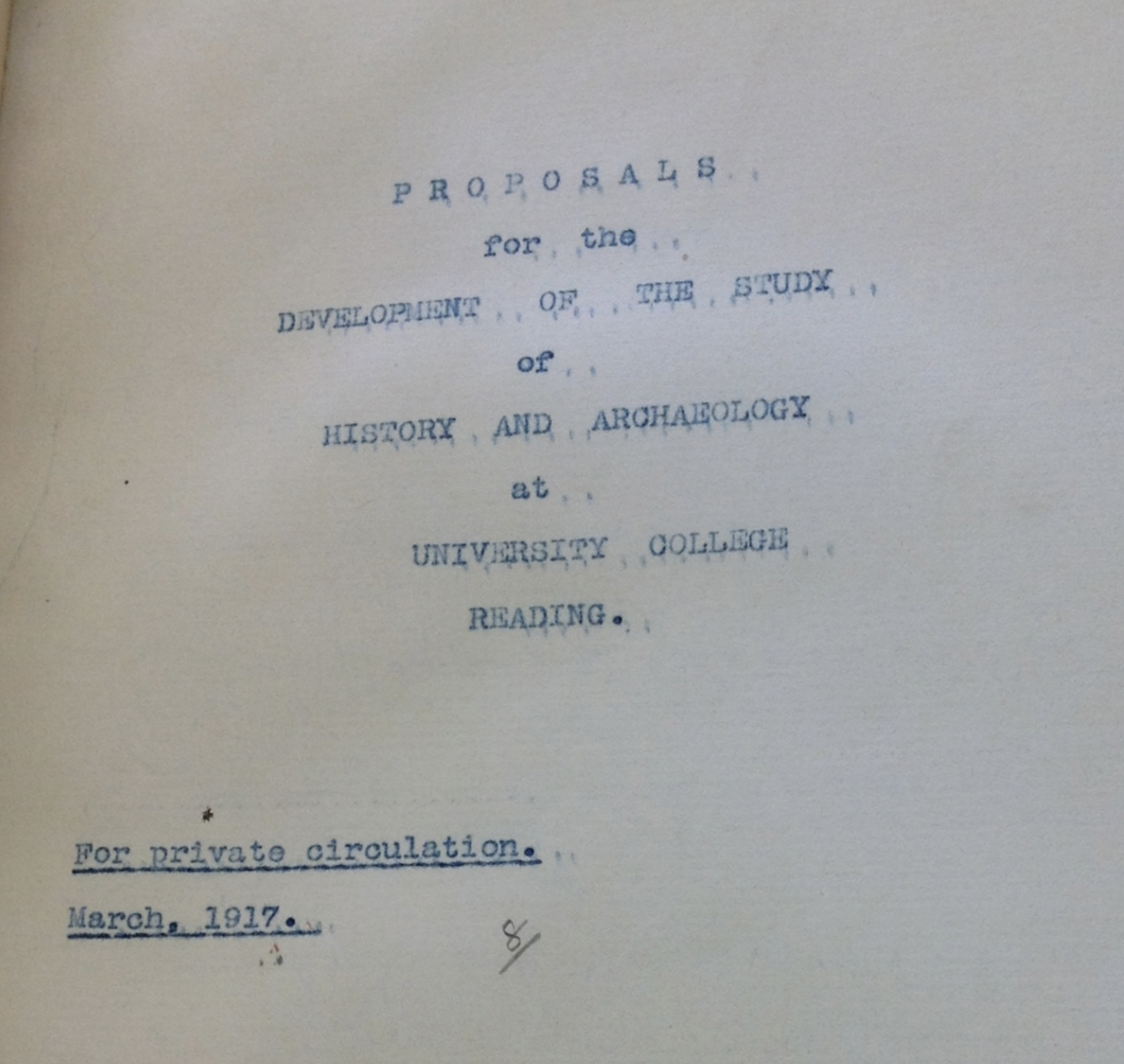By Amara Thornton (Research Officer, Ure Museum)
I’m continuing my research into the origins and history of the Ure Museum, and thanks to archivist Sharon Maxwell, the University History Collection is proving to be an illuminating resource. Sharon alerted me to a fascinating record which has revealed the efforts Percy Ure (Professor of Classics) and his colleague Frank Stenton (Professor of History) made to institute an interdisciplinary programme in History and Archaeology at University College Reading during the First World War, and the beginnings of the “Museum of History and Archaeology” at Reading.

The type-written pages of the record are bound into a hard-back cover book with gold lettering on the front spelling out “History Proposals”. The book contains lengthy ‘pitches’ Stenton and Ure made for the evolution of historical and archaeological teaching and research at the College.
It opens with a summary statement by Principal William Macbride Childs outlining the provision for history and archaeology to date. As part of his outline he references the archaeological collections “Scattered in inconvenient corners of the College”. It was Childs’ wish to see these all displayed in the same place, where “the intelligent visitor” could appreciate them as much as “scholars and students”, and further acquisitions would be possible.
A fund had been established to support the development of studies in local history and archaeology, and a further grant of funding by the College Council in 1913/1914 had enabled excavations at the site of Lowbury Hill, undertaken by Donald Atkinson (see my previous post). The Lowbury excavations were fruitful, resulting in the discovery of two human burials, one Anglo-Saxon and one Roman.
Both bodies and the artefacts found during the course of the excavation were brought back to the College where, Percy Ure noted, they could be seen “in cases which have been placed temporarily in passages and lobbies leading to the Library.” Some care was taken with the display, despite its temporary status, as the Anglo-Saxon skeleton was “set up in the position in which it lay in the barrow from the Saxon period till 1913.”
Percy Ure’s vision for the development of archaeology at the College embraced both Greece and Britain. He wanted to ensure the continuation of local excavations like that at Lowbury Hill alongside the continuation of his own excavations in Greece, and to incorporate student contributions and research (including his future wife, Annie Hunt, then a post-graduate student at Reading) into the mix. To this activity would be added the work that Frank Stenton and various history students at the College (including Stenton’s future wife Doris Parsons) were doing on medieval manuscripts and collections of relevance to local place names and histories. This way, Percy Ure proposed, the foundations would be laid for “establishing something that would ultimately deserve the name of a School of Ancient and Medieval History.”
Towards the end of the book Ure and Stenton made their financial case for the development of history and archaeology at Reading. This included “The proper ordering and display in a museum at the College of our existing archaeological and historical collections, and the development of these collections with the object of assisting study and research” as well as the need for specific funds for excavations and museum equipment.
By 1919, Percy Ure had married Annie Hunt, and Frank Stenton married Doris Parsons, and the four of them saw some of their plans come to fruition. That year the College leased Number 30 Portland Place, part of an elegant early 19th century building on London Road in Reading, and there the “Museum of History and Archaeology” was established. The “scattered collections” were now housed under one roof.
The story of the “Museum of History and Archaeology” is continued in another document, this time one I very recently came across in the Ure Museum archives. Written by Annie Ure, it is titled “The Museum of Greek Archaeology”, and it indicates that “The Museum of History and Archaeology” – the outcome of Percy Ure and Frank Stenton’s interdisciplinary vision – was a short-lived affair.

Annie Ure’s “Museum of Greek Archaeology” document referred to above is not the only document with that title in the Ure Museum archive. It would be easy to assume (as I did, initially) that all these documents are copies of the same text. But they aren’t. This particular typewritten document has some fantastic details about the “Museum of Greek Archaeology” as it existed at Number 28 Portland Place, where it remained until March 1957.
The new Museum had originally been two rooms on the ground floor, but the wall between the rooms was removed to create more space. The fireplaces that had been in each room featured “a solid Victorian mantelpiece of grey marble strong enough to support our two tombstones and other heavy exhibits.” The collection grew over as new purchases and gifts arrived. Consequently, Annie Ure recalled, “Steadily our elbow-room grew less and less.”
To be continued…
References
Childs, W. M., Stenton, F. and Ure, P. 1917. Proposals for the Developoment of the Study of History and Archaeology at University College Reading. [University History Collection, Special Collections, University of Reading].
Ure, Annie D. [Undated] The Museum of Greek Archaeology. [Ure Museum archive/D49]

